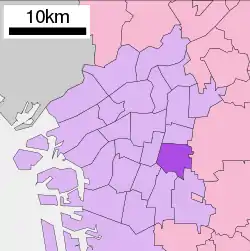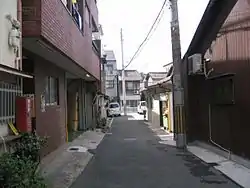Ikuno-ku, Osaka
Ikuno-ku (生野区) is one of 24 wards of Osaka, Japan. The Tsuruhashi (鶴橋) area of Ikuno-ku is well known for the large number of Koreans,[1] particularly Korean Japanese citizens (Zainichi Korean) living there, as well as for its large number of yakiniku (Korean-style barbecue) restaurants. Many families from Korea have lived in the Tsuruhashi district for three generations or more. Ikuno-ku is located in the southeastern part of Osaka City and is adjacent to Higashiosaka City in the east, Higashinari-ku of Osaka City in the north, Tennoji-ku in the west, and Abeno-ku, Higashisumiyoshi-ku and Hirano-ku in the south.



Population
The population and density of Ikuno-ku are the sixth largest in Osaka City, but are declining. The number of foreigner registrations is the largest in the city, and one out of four residents here is of foreign nationality. The proportion of senior citizens is also higher than the overall Osaka City average.
As aging of the population progresses in Ikuno-ku, diverse services and assistances are being provided for senior citizens. The municipal home nursing service center, Okachiyama, is among them. Ikuno-ku is thus evolving into a comfortable town for all its residents including senior citizens and handicapped residents, who will all be satisfied with their life here.
| Foreigners in Ikuno-ku,Osaka[2] | |
| Nationality | Population (2018) |
|---|---|
| 22,764 | |
| 2,269 | |
| 1,623 | |
| Others | 1,033 |
Living
Ikuno-ku is a typical town of small businesses from the pre-World War II period. Although the dense concentration of houses, factories and shops along narrow streets is a fire hazard, traditionally close human relationships contribute to an active local community. The narrow streets require substantial redevelopment. The completion of the Expressway Namba-Katae Line is eagerly awaited, as there are few east-west avenues.
Inside Ikuno-ku run JR Loop Line, Kintetsu Nara and Osaka Lines, as well as Subway Sennichimae Line, but none of them go through central Ikuno. The extension of Subway No.8 Line is strongly desired to provide the district citizens with railway transportation for everyday life.
Many projects are currently underway to develop the district into a comfortable residential area well balanced with its commercial and industrial functions. In southern Ikuno new apartment houses are being built for original residents, as well as many town squares. Construction of urban roads and parks is also planned. Residents of the Tsuruhashi area organized the New Town Development Committee, which was followed by the establishment of the New Tsuruhashi Redevelopment Association, both serving as a stimulus for residents-oriented town development.
Education
North Korean schools include:[3]
- East Osaka Korean Middle School (東大阪朝鮮中級学校)
- Ikuno Korean Elementary School (生野朝鮮初級学校)
- Osaka Korean No. 4 Elementary School (大阪朝鮮第四初級学校)
Transport
Rail
- West Japan Railway Company (These stations are located in Tennoji-ku but close to Ikuno-ku.)
- Kintetsu Railway
- Osaka Metro
- Sennichimae Line: Shoji Station - Kita-Tatsumi Station - Minami-Tatsumi Station
Road
- Katsuyama dori
- Imazatosuji
- National Route 25
- Uchi-kanjosen
Notable people
- Akiko Wada, Zainichi Korean singer and TV personality (Real Name: Kim Bokja, Hangul: 김복자)
- Hidekazu Mitsuyama, Japanese former baseball player
- Isao Taniguchi, Japanese former footballer
- Kawai Okada, Japanese former actress and businesswoman
- Kazuo Kitagawa, Japanese politician and former Minister of Agriculture, Forestry and Fisheries in the Japanese Cabinet of Junichiro Koizumi
- Keigo Higashino, Japanese mystery author
- Kenyu Sugimoto, Japanese footballer
- Ko Yong-hui, mother of North Korea's Supreme Commander, Kim Jong-un
- KONAN, Japanese singer, tarento, and gravure idol
- Maruse Taro, Zainichi Korean mime artist, comedian, vaudevillian and movie star
See also
- Shin-Ōkubo
References
- Ryall, Julian. "Big trouble in Little Korea: spiral of race hate grips Tokyo." (print title: "Big trouble in Little Korea") South China Morning Post. Wednesday 3 July 2013. Retrieved on 5 July 2013. "Shin-Okubo began attracting the Korean community about 30 years ago, says Shin Sang-yoon, a director of the chamber of commerce, simply because it was then one of the cheapest areas of Tokyo. It is a similar story in the Tsuruhashi area of Osaka,[...]"
- "生野区 外国人統計)". Retrieved April 14, 2018.
- "ウリハッキョ一覧" (Archive). Chongryon. Retrieved on October 14, 2015.
External links
![]() Media related to Ikuno-ku, Osaka at Wikimedia Commons
Media related to Ikuno-ku, Osaka at Wikimedia Commons